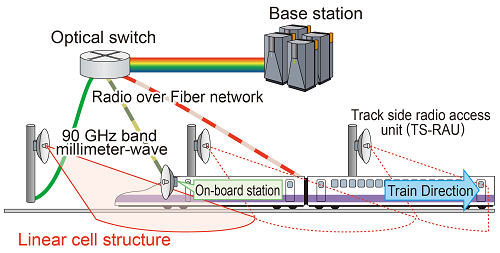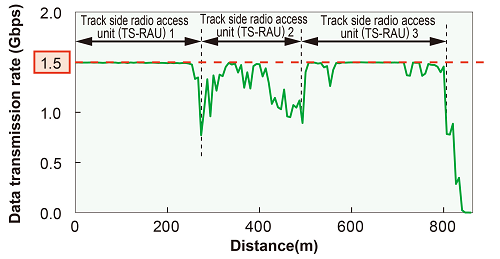28. Ground-to-train communication system using 90 GHz band millimeter-wave
Train radio systems used today have a narrow bandwidth of several kHz per channel, limiting the data rate that can be transmitted. As such frequency bands with wider bandwidths of several hundred MHz to several GHz were explored, which could be used to transmit large volumes of data.
Consequently, attention was focused on the 90 GHz band millimeter-wave which has not been used up until now on the railways, and the component technologies were developed for a ground-to-train communication system.
Based on measurement experiments carried out on viaducts and tunnels, and simulations, it was found that the 90 GHz band millimeter-wave propagation characteristics in the railway environment possessed certain features, such as the lower than free-space . The data relating to weather related attenuation (due to rain fall and/or snow adhesion, etc.) needed for the design of a radio circuit was then collected. A new ground-to-train communication system (Fig. 1) was proposed that combined the 90 GHz band millimeter-wave with Radio over Fiber (RoF) technology, which was then tried out in a demonstration test.
Test results showed that aside from a change in the data transmission rate at one point due to a different antenna angle, track side radio access units (TS-RAUs) connected to the base station were switched at high speed using an optical switch, in accordance with the train running at a speed of about 240 km/h.
Consequently, it was verified that data transmission rate was maintained as transmission moved on from one TS-RAU to the next, and that it was possible to continuously transmit data up to a rate of approximately 1.5Gbps (Fig. 2). The results of simulations to estimate radio transmission quality also showed that the new system could probably be used at speeds of over 300 km/h.
These outcomes suggest that the new ground-to-train communication system could allow transmission of up to 750 times more data than is possible with existing systems. Consequently, with the new system it would be possible to stream train condition monitoring data and security camera images to ground in real time.
Other Contents
- 26. Head car collision testing and numerical simulation
- 27. Snow accretion simulation method for high speed trains
- 28. Ground-to-train communication system using 90 GHz band millimeter-wave
- 29. Mechanisms underlying slope collapse due to rain or during an earthquake resulting from changes in water content of volcanic soil
- 30. Factors influencing concrete deterioration due to expansion
- 26. Head car collision testing and numerical simulation
- 27. Snow accretion simulation method for high speed trains
- 28. Ground-to-train communication system using 90 GHz band millimeter-wave
- 29. Mechanisms underlying slope collapse due to rain or during an earthquake resulting from changes in water content of volcanic soil
- 30. Factors influencing concrete deterioration due to expansion


